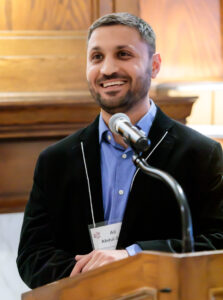SAN DIEGO—Gout has sometimes been called the disease of kings, not only because of the fact that purine-rich foods were long affordable only to wealthier individuals, but also because the disease has been around since the monarchies that existed centuries ago. However, with groundbreaking research leading to a better understanding of gout, we can now see this disease in a different light than in ages past. At the session titled, The Word Is Out: New Mechanisms and Targets of Gout, several paradigm-shifting ideas were put forth by two esteemed researchers on this subject.
Inflammasomes & the Pathophysiology of Gout

Ali Abdul-Sater, PhD Photo: York University, Toronto
The first speaker was Ali Abdul-Sater, PhD, associate professor in the faculty of health, York University, Toronto. To explain the work being undertaken in Dr. Abdul-Sater’s lab, it is first important to understand the concept of the inflammasome and how this relates to the pathophysiology of gout.
Inflammasomes are innate immune system receptors and sensors that are involved in the promulgation and regulation of caspase-1 and become more active in response to infectious microbes and molecules from host proteins.1 The concept of the inflammasome is relevant in gout given that, in acute flares, monosodium urate (MSU) crystals are engulfed by resident synovial macrophages, which in turn activate the NLRP3 inflammasome. Interleukin-1 (IL-1) beta is subsequently released into the joint space and into the systemic circulation. Neutrophils can then proliferate, enter the joint and engulf MSU crystals. This process results in joint pain and swelling.
With this context in mind, Dr. Abdul-Sater explained that dysregulation of inflammasomes, such as NLRP3, has been implicated in inflammatory arthritides, such as gout. Further, that tight regulation of this inflammasome may be important in preventing disease. Tumor necrosis factor receptor-associated factor 1 (TRAF1) is a signaling adapter that can participate in this type of regulation. TRAF1 has been linked to a heightened risk of inflammatory arthritis, such as with rheumatoid arthritis.
Because the linear ubiquitin chain assembly complex helps regulate the NLRP3 inflammasome and because TRAF1 participates in the sequestration of the linear ubiquitin assembly complex known as LUBAC, Dr. Abdul-Sater and colleagues speculated that TRAF1 may help control NLRP3 inflammasome activation. They demonstrated that TRAF1 knockout mice exhibit increased inflammatory cell recruitment in an NLRP3 inflammasome in vivo model, and these mice are more susceptible to MSU crystal-induced gout. In addition, this team showed that targeting the TRAF1/cIAP2 axis lowers inflammation and IL-1beta production.
The implication of these findings is that TRAF1 may be a possible therapeutic target for inflammasome-driven diseases like gout.2

Michael Pillinger, MD
Endothelial & Vascular Dysfunction in Gout
The second speaker in the session was Michael Pillinger, MD, professor of medicine and of biochemistry and molecular pharmacology, NYU Grossman School of Medicine, New York. He discussed how gout treatment may or may not affect endothelial and vascular dysfunction.
To begin his presentation, Dr. Pillinger explained that there are four elements to gout as we know it:
- Hyperuricemia;
- MSU crystal formation and deposition;
- Disease flares; and
- Tophi.
However, this conceptual framework ignores the effects that gout may have on the vasculature, and indeed, Dr. Pillinger says this should serve as a fifth element of how we understand the disease.
In terms of the effects that gout has on the vasculature, it is notable that patients with gout have higher rates of cardiovascular disease (CVD) than the general population. Rates of CVD are more similar to those seen in patients with rheumatoid arthritis and psoriatic arthritis. Dr. Pillinger referenced work that shows how hyperuricemia is associated with hypertension, systemic inflammation and CVD via endothelial dysfunction and abnormal vascular remodeling. In fact, there is evidence that soluble urate inhibits endothelial cell production of nitric oxide (NO).3 This is an important observation because NO mediates endothelium-dependent relaxation, inhibits platelet aggregation, prevents platelet adhesion to endothelial surfaces and induces disaggregation of platelets.
Given these findings, Dr. Pillinger described a study (in which he was a co-author) that sought to assess if gout therapy with colchicine and a urate-lowering xanthine oxidase inhibitor (XOI) could improve arterial function and reduce inflammation in patients. In this study, 38 patients with untreated gout received colchicine (in a dose of 0.6 mg twice daily or once daily based on ability to tolerate the medication) and an XOI (allopurinol or febuxostat) that was titrated to ACR guideline-defined serum urate target. Treatment was initiated during periods in between gout flares, and the start of treatment with colchicine and XOI were staggered to allow for assessment of a potential independent effect of colchicine alone.
Dr. Pillinger and colleagues used brachial artery flow-mediated dilation to measure endothelium-dependent arterial responsiveness and nitrate-mediated dilation to measure endothelium-independent arterial responsiveness. This team also used high-sensitivity C-reactive protein (hsCRP), IL-1β, IL-6, myeloperoxidase (MPO) concentrations, and erythrocyte sedimentation rate (ESR) to evaluate systemic inflammation.
What they found is that the initiation of guideline-based gout treatment reduced systemic inflammation between gout flares and improved endothelial-dependent arterial function, especially in patients without established cardiovascular comorbidities.4
These findings imply that colchicine and XOI therapies may be able to help reduce systemic inflammation and endothelial dysfunction even in intercritical periods, meaning the time between gout flares.
In Sum
The entirety of the session was fascinating and stimulating. It proves the point that, even when it seems not much more can be gleaned about an old disease, there are always methods by which to come away from the discussion with new and innovative ideas.
 Jason Liebowitz, MD, is an assistant professor of medicine in the Division of Rheumatology at Columbia University Vagelos College of Physicians and Surgeons, New York.
Jason Liebowitz, MD, is an assistant professor of medicine in the Division of Rheumatology at Columbia University Vagelos College of Physicians and Surgeons, New York.
References
- Guo H, Callaway JB, Ting JP. Inflammasomes: Mechanism of action, role in disease, and therapeutics. Nat Med. 2015;21(7):677–687.
- Mirzaesmaeili A, Zangiabadi S, Raspanti J, et al. Cutting edge: Negative regulation of inflammasome activation by TRAF1 can limit gout. J Immunol. 2023 Mar 1;210(5):531–535.
- Kang DH, Park SK, Lee IK, Johnson RJ. Uric acid-induced C-reactive protein expression: Implication on cell proliferation and nitric oxide production of human vascular cells. J Am Soc Nephrol. 2005;16(12):3553–3562.
- Toprover M, Shah B, Oh C, et al. Initiating guideline-concordant gout treatment improves arterial endothelial function and reduces intercritical inflammation: A prospective observational study. Arthritis Res Ther. 2020 Jul 11;22(1):169.
